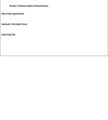1. Evidence-based practice
Defining the nature of best evidence for policy and practice
Simon Igo
Introduction
Evidence-based practice (EBP) is a ubiquitous term in dietetic practice and has become a major policy theme in the modernisation of the British National Health Service. One of the biggest challenges for the modern-day healthcare professional, manager and policy maker is to apply the principles of evidence-based practice in a changing and complex clinical, political and economic healthcare arena.
An evidence-based approach in dietetic practice is founded on ‘a model of clinical reasoning that uses a systematic process to integrate best evidence (research) with clinical expertise and patient values to optimise patient care’. 1.2. and 3. Engaging with clinical research and other forms of ‘best evidence’ widens the professional knowledge base, contributes towards improved patient care, leads to economic savings in healthcare practice and improves knowledge and skill development in dietetic practice. 4
Despite the perception of being ubiquitous, some authors argue that EBP has not achieved the acceptance that it set out to accomplish; common reported barriers that preclude the application into clinical practice include an inflexible organisational culture, inadequate resources (time, staffing or finance), insufficient skills and limited knowledge. 5.6.7. and 8. In addition to these political, economic and organisational barriers there are fundamental philosophical concerns that relate to the theoretical framework that underpins EBP. Essentially, the process of EBP is grounded on the premise that best evidence in the form of high-quality research will enable sound clinical decision-making. However, critical debate as to what constitutes best evidence and how to apply evidence remains, at best, confusing. Thus healthcare practitioners and policy makers remain uncertain about the nature and application of an EBP approach to healthcare decision-making. 9,10
This chapter will revisit the notion of best evidence and will offer a pragmatic and practical classification that will help dietitians to understand the nature of best evidence and to understand how to apply best evidence in healthcare practice.
From evidence-based medicine to evidence-based practice
In its simplest form evidence-based medicine (EBM) is an approach to clinical problem solving: it is defined as ‘the conscientious, explicit and judicious use of current best evidence in making decisions about the care of individual patients’; 1 a process of systematically finding, appraising and using research findings to inform healthcare practice, and follows four basic steps:
1. Formulate a clear clinical question from a patient’s problem;
2. Search the literature for relevant clinical articles;
3. Evaluate (critically appraise) the evidence for its validity and usefulness; and
4. Implement useful findings in clinical practice. 11
Liberati and Vineis trace the origins of EBM back to mid-nineteenth-century Paris where proponents of a new movement called ‘medicine d’observation’ were attempting to reject the notion of medical care-based speculation12; however, it is widely accepted that modern contemporary practice originated at McMaster’s University in 1981. The faculty of the Department of Clinical Epidemiology and Biostatistics published a series of articles for the Canadian Medical Association Journal that taught clinicians how to critically appraise medical literature, and developed an awareness of the relationship between research and clinical practice. 13
This philosophical approach was formalised in 1992 in a paper written by the Evidence Based Medicine Working Group (EBMWG) the authors present the reader with two alternatives for clinical decision-making. 14 The first, ‘the way of the past’, novice physicians seek expert and experienced opinion from authorities higher in the medical hierarchy: expert opinion and past precedent informs practice. However, a second and more robust option is presented, one that represents a shift away from opinion towards the critical use of medical literature to enable physicians to make sound clinical judgements; this method was seen as ‘the way of the future’ and the term ‘evidence-based medicine’ was coined.
Understanding the origins and history of the evidence-based medicine movement identifies that EBM evolved within a biomedical philosophy and has been shaped by key thinkers in the medical, biological, epidemiological and statistical sciences. Early adopters developed EBM within a positivist research framework, the premise being that the use of empirically based quantitative research methodologies would answer patient dilemmas and solve the issue of using non-substantiated evidence in the form of personal opinion.
The term evidence-based ‘medicine’ was rejected by healthcare professions such as dietitians and other professions allied to health on the grounds that the medical model of clinical decision-making did not reflect the different scientific philosophies, professional values and approaches to healthcare. 15,16 Professions allied to health have different professional identities and values that are paradigmatically different to that of medicine. Subsequently, an alternative term was adopted, one that accepted other forms of evidence and enabled clinical decision-making in a wider professional context. The term ‘evidence-based practice’ was created, a process that evolved from the school and teachings of EBM but recognised a broader selection of evidence within the context of healthcare. 13
Defining best evidence
So what do we mean by best evidence in dietetic practice and how should we apply best evidence in the clinical setting? Traditionally evidence has been categorised into hierarchies constructed within an empirically based positivist research paradigm. Hierarchies classify evidence in terms of how valid the results are for determining the effectiveness of an intervention. Systematic reviews, randomised controlled trials (RCTs) and other quantitative-based approaches are used to help determine the effectiveness of clinical practice; the more robust the research method, the more valid the result. Moore proposed one such hierarchy of evidence combining primary and secondary research methods and, to date, it still underpins the use of quantitative-based research in EBP (Table 1.1). 17
| I | Strong evidence from at least one systematic review of multiple well-designed randomised controlled trials. |
| II | Strong evidence from at least one properly designed randomised controlled trial of appropriate size. |
| III | Evidence from well-designed trials without randomisation, single-group pre-post cohort, time series or matched case controlled studies. |
| IV | Evidence from non-experimental studies from more than one centre or research group. |
| V | Opinions of respected authorities, based on clinical evidence, descriptive studies or reports from expert committees |
A brief critical review of such hierarchies quickly reveals the noticeable absence of other sources of evidence including qualitative naturalistic research. This raises some fundamental questions for practising dieticians: How appropriate are such hierarchies and are we missing other sources of important evidence? What about the nature of interpretive research paradigm using qualitative research methodologies and where does clinical knowledge fit into the EBP framework? To answer these questions it is necessary to revisit what we mean by best evidence and consider other forms of clinical research, our clinical knowledge and practice experience, and the notion of reflective practice when we attempt to apply and use best evidence.
The nature of best evidence
The previous section has identified that the use of ordered quantitative-based evidence is useful but perhaps limited for the complex clinical arena that constitutes dietetic practice. The philosophy that clinical research should be used to inform practice is at the heart of the EBP movement, but it needs to be defined so that it can be applied within the context of clinical practice.
Fundamentally research, or research-based knowledge, 18 can be categorised into two broad camps, the ‘empirico analytical paradigm’ and the ‘interpretive paradigm’. 19 Evidence associated with the former includes methods associated with quantitative research methodology but also incorporates biological and pathological theory. 10 Evidence that sits in this framework of knowledge is invaluable for informing practice and policy relating to treatment, therapy and diagnosis.
Evidence associated with the ‘interpretative paradigm’ includes research approaches framed within qualitative methodology including studies allied to humanities and social science. The importance of such evidence is no less important than its quantitative cousin but it seeks to answer different clinical questions. Using evidence, framed within the interpretive paradigm, allows policy makers and clinicians to understand the nature of the healthcare experience and will allow for a deeper understanding of healthcare behaviour.
So when faced with a particular clinical dilemma or situation classifying the nature of evidence into an ‘empirico analytical’ or ‘interpretive’ framework begins to narrow down the type of evidence that could be used to help understand the key issues in clinical practice; identifying the type of evidence for clinical decision-making is elaborated in the next section.
Methods for translating evidence into practice: choosing the right question
The previous section briefly summarises two separate research paradigms; understanding where evidence falls within these frameworks is the key to applying best evidence. But how should evidence be applied?
Mulhall recognises the need for using appropriate sources of evidence and offers an intuitive approach, an approach commensurate with clinical reasoning. 20 Mulhall suggests that the clinical question dictates the choice of evidence. Like research questions the clinical question can be categorised in terms of their purpose and the purpose of the clinical question can be aligned to one of the research paradigms indicating a choice of evidence to help inform clinical practice. 21




Stay updated, free articles. Join our Telegram channel

Full access? Get Clinical Tree




